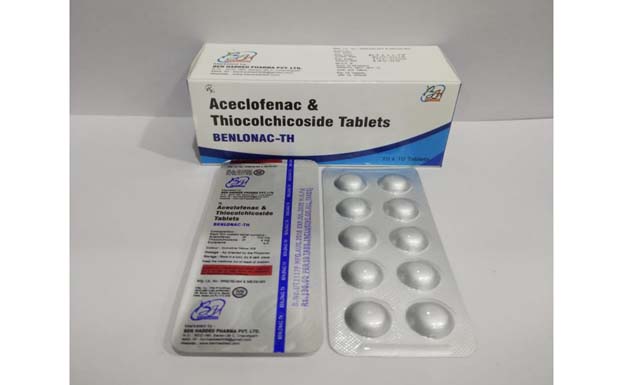This is a combination of two medicines: Thiocolchicoside and Aceclofenac, which relieves muscle pain, body ache and fever. Thiocolchicoside is a muscle relaxant. It works on the centers in the brain and spinal cord to relieve muscle stiffness or spasm and improve movement of muscles. Aceclofenac produces analgesia by elevation of the pain threshold and antipyretic effect through action on the hypothalamic heat- regulating center by inhibiting prostaglandin synthesis.
Fever
Mild pain
Pain
Severe Pain
Minor aches and pains
Moderate Pain
Aceclofenac is a NSAID that inhibits both isoforms of COX enzyme, a key enzyme involved in the inflammatory process. Through COX-2 inhibition, aceclofenac downregulates the production of various inflammatory mediators including prostaglandin E2 (PGE2), IL-1β, and TNF from the arachidonic acid (AA) pathway.
Thiocolchicoside is a skeletal muscle-relaxant drug that works through selective binding to the GABA-A receptor. It prevents muscle contractions by activating the GABA inhibitory motor pathway. This medication acts as a competitive GABA receptor antagonist and inhibits glycine receptors with similar potency as nicotinic acetylcholine receptors.
Aceclofenac is rapidly and completely absorbed from GIT. Time to reach maximum concentration in plasma is about 1.23-3 hours. It is highly bound protein drug with 99% and the volume of distribution is about 25 L. It is metabolised by CYP enzyme family and 70-80% of the metabolites are excreted in urine with only 20% excreted in feces. The half-life is approximately 4 hours.
Paracetamol is also well orally absorbed and volume of distribution is 1.29 l/kg. Protein binding of paracetamol is very negligible. It is metabolised in liver mainly by CYP enzymes. Paracetamol is mainly excreted in urine with a half-life of 3.6 hours.
Thiocolchicoside has only 25% bioavailability. When 8mg administered intramuscularly then the volume of distribution is 42.7 L. It is metabolised in intestine and there are three major metabolites. The first metabolite undergoes conjugation to produce active metabolite or undergoes demethylation to produce inactive metabolite. About 79% of the metabolites are excreted in feces and 20% in urine. The half-life is approximately 7.7 hours.
Common side effect includes:
Stomach pain
Nausea
Vomiting
Stomach ulcers
Blood cell disorders
Following drugs may interact with the product includes:
Lithium and digoxin
Diuretics or ciclosporin.
Ace inhibitors
Anticoagulants
Quinolones.
Carefully use paracetamol suspension in the following conditions:
Active, or history of recurrent peptic ulcer/haemorrhage
Asthma
Rhinitis
Hepatic failure
Renal failure
Congestive heart failure

| Aceclofenac | 200 mg |
| Thiocolchicoside | 4 mg |
